Collaborative Nursing Practice for Ischemic Stroke: Clinical Judgement, Evidence-Based Practice, and Challenges
VerifiedAdded on 2023/06/11
|14
|5675
|416
AI Summary
This essay discusses the clinical condition of Mr. ABC who has been diagnosed with ischemic stroke and critically evaluates pertinent pathophysiology and pharmacology. It also demonstrates the nursing clinical judgements and decision-making process and presents evidence-based practice and contemporary applicable frameworks. The essay further discusses the concept of collaborative working and highlights merits and challenges faced by healthcare providers in achieving patient collaborative care.
Contribute Materials
Your contribution can guide someone’s learning journey. Share your
documents today.
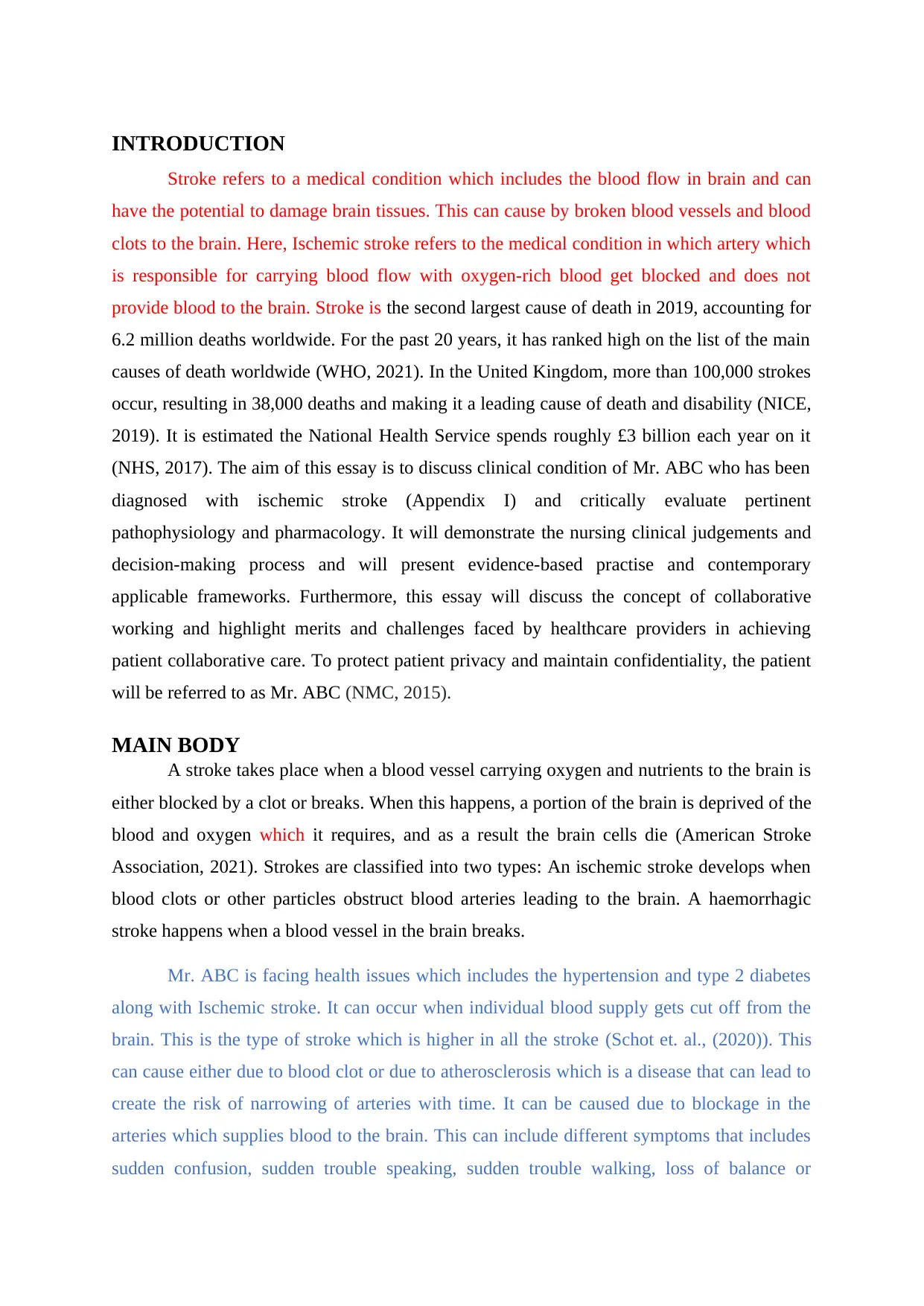
INTRODUCTION
Stroke refers to a medical condition which includes the blood flow in brain and can
have the potential to damage brain tissues. This can cause by broken blood vessels and blood
clots to the brain. Here, Ischemic stroke refers to the medical condition in which artery which
is responsible for carrying blood flow with oxygen-rich blood get blocked and does not
provide blood to the brain. Stroke is the second largest cause of death in 2019, accounting for
6.2 million deaths worldwide. For the past 20 years, it has ranked high on the list of the main
causes of death worldwide (WHO, 2021). In the United Kingdom, more than 100,000 strokes
occur, resulting in 38,000 deaths and making it a leading cause of death and disability (NICE,
2019). It is estimated the National Health Service spends roughly £3 billion each year on it
(NHS, 2017). The aim of this essay is to discuss clinical condition of Mr. ABC who has been
diagnosed with ischemic stroke (Appendix I) and critically evaluate pertinent
pathophysiology and pharmacology. It will demonstrate the nursing clinical judgements and
decision-making process and will present evidence-based practise and contemporary
applicable frameworks. Furthermore, this essay will discuss the concept of collaborative
working and highlight merits and challenges faced by healthcare providers in achieving
patient collaborative care. To protect patient privacy and maintain confidentiality, the patient
will be referred to as Mr. ABC (NMC, 2015).
MAIN BODY
A stroke takes place when a blood vessel carrying oxygen and nutrients to the brain is
either blocked by a clot or breaks. When this happens, a portion of the brain is deprived of the
blood and oxygen which it requires, and as a result the brain cells die (American Stroke
Association, 2021). Strokes are classified into two types: An ischemic stroke develops when
blood clots or other particles obstruct blood arteries leading to the brain. A haemorrhagic
stroke happens when a blood vessel in the brain breaks.
Mr. ABC is facing health issues which includes the hypertension and type 2 diabetes
along with Ischemic stroke. It can occur when individual blood supply gets cut off from the
brain. This is the type of stroke which is higher in all the stroke (Schot et. al., (2020)). This
can cause either due to blood clot or due to atherosclerosis which is a disease that can lead to
create the risk of narrowing of arteries with time. It can be caused due to blockage in the
arteries which supplies blood to the brain. This can include different symptoms that includes
sudden confusion, sudden trouble speaking, sudden trouble walking, loss of balance or
Stroke refers to a medical condition which includes the blood flow in brain and can
have the potential to damage brain tissues. This can cause by broken blood vessels and blood
clots to the brain. Here, Ischemic stroke refers to the medical condition in which artery which
is responsible for carrying blood flow with oxygen-rich blood get blocked and does not
provide blood to the brain. Stroke is the second largest cause of death in 2019, accounting for
6.2 million deaths worldwide. For the past 20 years, it has ranked high on the list of the main
causes of death worldwide (WHO, 2021). In the United Kingdom, more than 100,000 strokes
occur, resulting in 38,000 deaths and making it a leading cause of death and disability (NICE,
2019). It is estimated the National Health Service spends roughly £3 billion each year on it
(NHS, 2017). The aim of this essay is to discuss clinical condition of Mr. ABC who has been
diagnosed with ischemic stroke (Appendix I) and critically evaluate pertinent
pathophysiology and pharmacology. It will demonstrate the nursing clinical judgements and
decision-making process and will present evidence-based practise and contemporary
applicable frameworks. Furthermore, this essay will discuss the concept of collaborative
working and highlight merits and challenges faced by healthcare providers in achieving
patient collaborative care. To protect patient privacy and maintain confidentiality, the patient
will be referred to as Mr. ABC (NMC, 2015).
MAIN BODY
A stroke takes place when a blood vessel carrying oxygen and nutrients to the brain is
either blocked by a clot or breaks. When this happens, a portion of the brain is deprived of the
blood and oxygen which it requires, and as a result the brain cells die (American Stroke
Association, 2021). Strokes are classified into two types: An ischemic stroke develops when
blood clots or other particles obstruct blood arteries leading to the brain. A haemorrhagic
stroke happens when a blood vessel in the brain breaks.
Mr. ABC is facing health issues which includes the hypertension and type 2 diabetes
along with Ischemic stroke. It can occur when individual blood supply gets cut off from the
brain. This is the type of stroke which is higher in all the stroke (Schot et. al., (2020)). This
can cause either due to blood clot or due to atherosclerosis which is a disease that can lead to
create the risk of narrowing of arteries with time. It can be caused due to blockage in the
arteries which supplies blood to the brain. This can include different symptoms that includes
sudden confusion, sudden trouble speaking, sudden trouble walking, loss of balance or
Secure Best Marks with AI Grader
Need help grading? Try our AI Grader for instant feedback on your assignments.
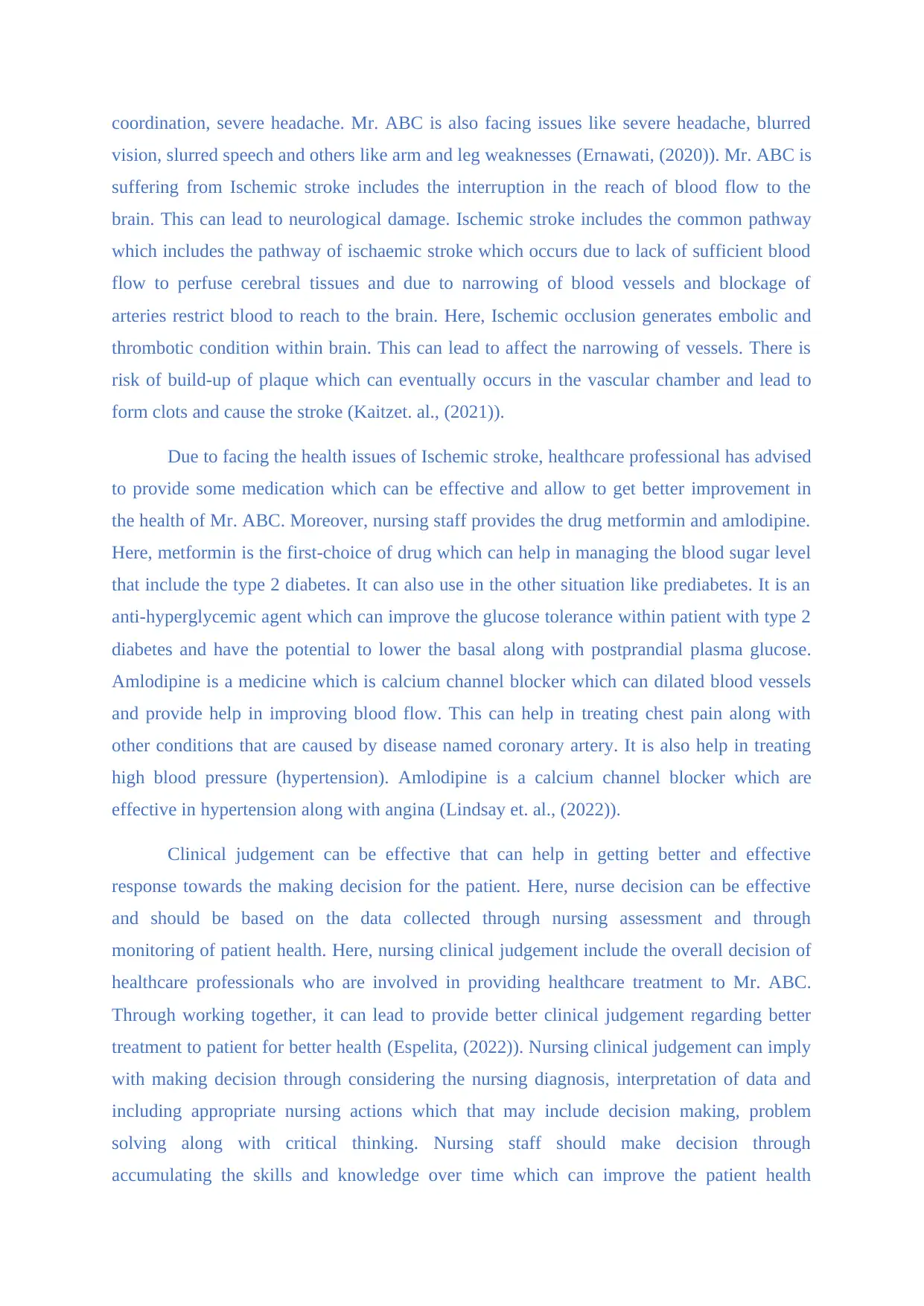
coordination, severe headache. Mr. ABC is also facing issues like severe headache, blurred
vision, slurred speech and others like arm and leg weaknesses (Ernawati, (2020)). Mr. ABC is
suffering from Ischemic stroke includes the interruption in the reach of blood flow to the
brain. This can lead to neurological damage. Ischemic stroke includes the common pathway
which includes the pathway of ischaemic stroke which occurs due to lack of sufficient blood
flow to perfuse cerebral tissues and due to narrowing of blood vessels and blockage of
arteries restrict blood to reach to the brain. Here, Ischemic occlusion generates embolic and
thrombotic condition within brain. This can lead to affect the narrowing of vessels. There is
risk of build-up of plaque which can eventually occurs in the vascular chamber and lead to
form clots and cause the stroke (Kaitzet. al., (2021)).
Due to facing the health issues of Ischemic stroke, healthcare professional has advised
to provide some medication which can be effective and allow to get better improvement in
the health of Mr. ABC. Moreover, nursing staff provides the drug metformin and amlodipine.
Here, metformin is the first-choice of drug which can help in managing the blood sugar level
that include the type 2 diabetes. It can also use in the other situation like prediabetes. It is an
anti-hyperglycemic agent which can improve the glucose tolerance within patient with type 2
diabetes and have the potential to lower the basal along with postprandial plasma glucose.
Amlodipine is a medicine which is calcium channel blocker which can dilated blood vessels
and provide help in improving blood flow. This can help in treating chest pain along with
other conditions that are caused by disease named coronary artery. It is also help in treating
high blood pressure (hypertension). Amlodipine is a calcium channel blocker which are
effective in hypertension along with angina (Lindsay et. al., (2022)).
Clinical judgement can be effective that can help in getting better and effective
response towards the making decision for the patient. Here, nurse decision can be effective
and should be based on the data collected through nursing assessment and through
monitoring of patient health. Here, nursing clinical judgement include the overall decision of
healthcare professionals who are involved in providing healthcare treatment to Mr. ABC.
Through working together, it can lead to provide better clinical judgement regarding better
treatment to patient for better health (Espelita, (2022)). Nursing clinical judgement can imply
with making decision through considering the nursing diagnosis, interpretation of data and
including appropriate nursing actions which that may include decision making, problem
solving along with critical thinking. Nursing staff should make decision through
accumulating the skills and knowledge over time which can improve the patient health
vision, slurred speech and others like arm and leg weaknesses (Ernawati, (2020)). Mr. ABC is
suffering from Ischemic stroke includes the interruption in the reach of blood flow to the
brain. This can lead to neurological damage. Ischemic stroke includes the common pathway
which includes the pathway of ischaemic stroke which occurs due to lack of sufficient blood
flow to perfuse cerebral tissues and due to narrowing of blood vessels and blockage of
arteries restrict blood to reach to the brain. Here, Ischemic occlusion generates embolic and
thrombotic condition within brain. This can lead to affect the narrowing of vessels. There is
risk of build-up of plaque which can eventually occurs in the vascular chamber and lead to
form clots and cause the stroke (Kaitzet. al., (2021)).
Due to facing the health issues of Ischemic stroke, healthcare professional has advised
to provide some medication which can be effective and allow to get better improvement in
the health of Mr. ABC. Moreover, nursing staff provides the drug metformin and amlodipine.
Here, metformin is the first-choice of drug which can help in managing the blood sugar level
that include the type 2 diabetes. It can also use in the other situation like prediabetes. It is an
anti-hyperglycemic agent which can improve the glucose tolerance within patient with type 2
diabetes and have the potential to lower the basal along with postprandial plasma glucose.
Amlodipine is a medicine which is calcium channel blocker which can dilated blood vessels
and provide help in improving blood flow. This can help in treating chest pain along with
other conditions that are caused by disease named coronary artery. It is also help in treating
high blood pressure (hypertension). Amlodipine is a calcium channel blocker which are
effective in hypertension along with angina (Lindsay et. al., (2022)).
Clinical judgement can be effective that can help in getting better and effective
response towards the making decision for the patient. Here, nurse decision can be effective
and should be based on the data collected through nursing assessment and through
monitoring of patient health. Here, nursing clinical judgement include the overall decision of
healthcare professionals who are involved in providing healthcare treatment to Mr. ABC.
Through working together, it can lead to provide better clinical judgement regarding better
treatment to patient for better health (Espelita, (2022)). Nursing clinical judgement can imply
with making decision through considering the nursing diagnosis, interpretation of data and
including appropriate nursing actions which that may include decision making, problem
solving along with critical thinking. Nursing staff should make decision through
accumulating the skills and knowledge over time which can improve the patient health
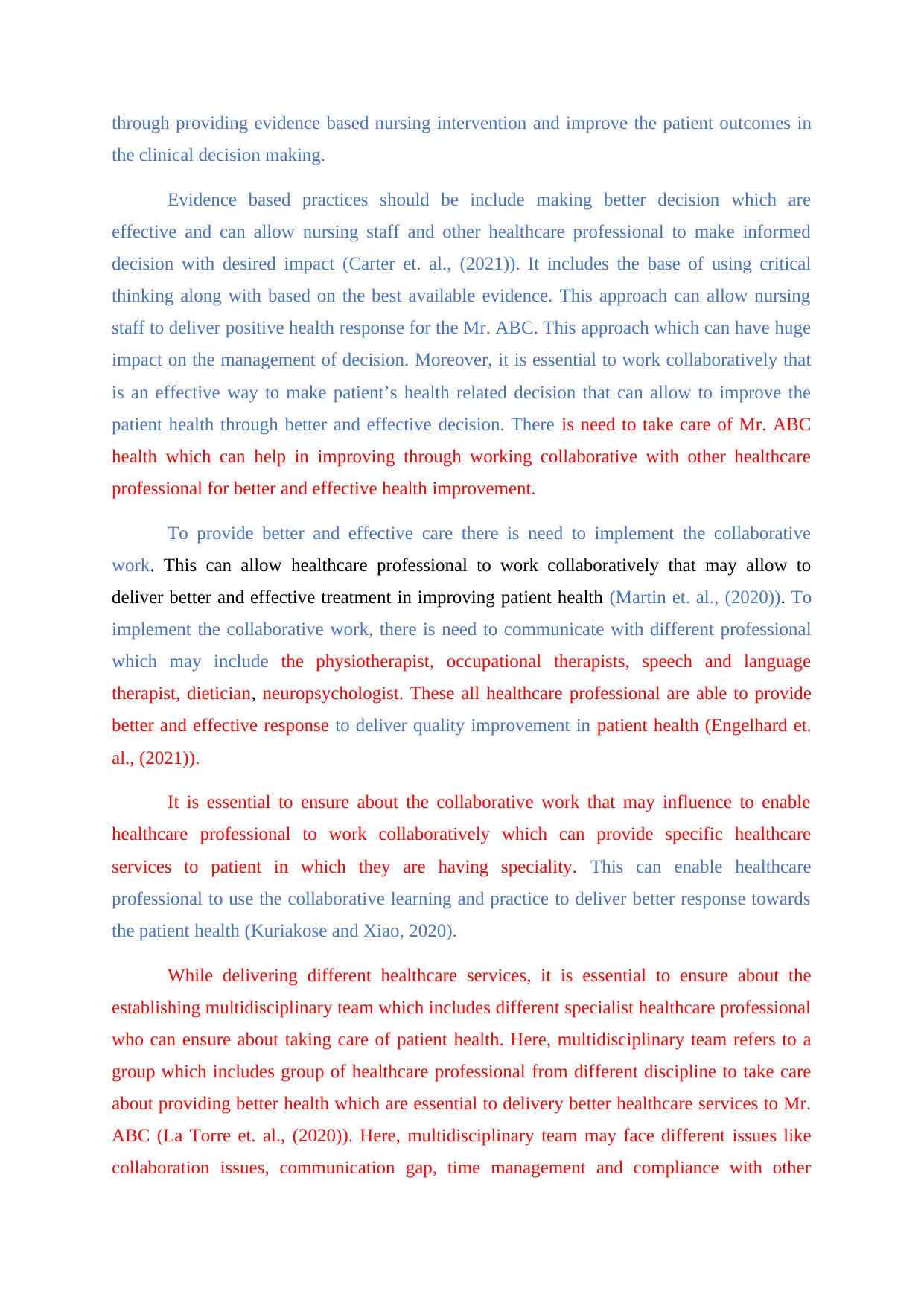
through providing evidence based nursing intervention and improve the patient outcomes in
the clinical decision making.
Evidence based practices should be include making better decision which are
effective and can allow nursing staff and other healthcare professional to make informed
decision with desired impact (Carter et. al., (2021)). It includes the base of using critical
thinking along with based on the best available evidence. This approach can allow nursing
staff to deliver positive health response for the Mr. ABC. This approach which can have huge
impact on the management of decision. Moreover, it is essential to work collaboratively that
is an effective way to make patient’s health related decision that can allow to improve the
patient health through better and effective decision. There is need to take care of Mr. ABC
health which can help in improving through working collaborative with other healthcare
professional for better and effective health improvement.
To provide better and effective care there is need to implement the collaborative
work. This can allow healthcare professional to work collaboratively that may allow to
deliver better and effective treatment in improving patient health (Martin et. al., (2020)). To
implement the collaborative work, there is need to communicate with different professional
which may include the physiotherapist, occupational therapists, speech and language
therapist, dietician, neuropsychologist. These all healthcare professional are able to provide
better and effective response to deliver quality improvement in patient health (Engelhard et.
al., (2021)).
It is essential to ensure about the collaborative work that may influence to enable
healthcare professional to work collaboratively which can provide specific healthcare
services to patient in which they are having speciality. This can enable healthcare
professional to use the collaborative learning and practice to deliver better response towards
the patient health (Kuriakose and Xiao, 2020).
While delivering different healthcare services, it is essential to ensure about the
establishing multidisciplinary team which includes different specialist healthcare professional
who can ensure about taking care of patient health. Here, multidisciplinary team refers to a
group which includes group of healthcare professional from different discipline to take care
about providing better health which are essential to delivery better healthcare services to Mr.
ABC (La Torre et. al., (2020)). Here, multidisciplinary team may face different issues like
collaboration issues, communication gap, time management and compliance with other
the clinical decision making.
Evidence based practices should be include making better decision which are
effective and can allow nursing staff and other healthcare professional to make informed
decision with desired impact (Carter et. al., (2021)). It includes the base of using critical
thinking along with based on the best available evidence. This approach can allow nursing
staff to deliver positive health response for the Mr. ABC. This approach which can have huge
impact on the management of decision. Moreover, it is essential to work collaboratively that
is an effective way to make patient’s health related decision that can allow to improve the
patient health through better and effective decision. There is need to take care of Mr. ABC
health which can help in improving through working collaborative with other healthcare
professional for better and effective health improvement.
To provide better and effective care there is need to implement the collaborative
work. This can allow healthcare professional to work collaboratively that may allow to
deliver better and effective treatment in improving patient health (Martin et. al., (2020)). To
implement the collaborative work, there is need to communicate with different professional
which may include the physiotherapist, occupational therapists, speech and language
therapist, dietician, neuropsychologist. These all healthcare professional are able to provide
better and effective response to deliver quality improvement in patient health (Engelhard et.
al., (2021)).
It is essential to ensure about the collaborative work that may influence to enable
healthcare professional to work collaboratively which can provide specific healthcare
services to patient in which they are having speciality. This can enable healthcare
professional to use the collaborative learning and practice to deliver better response towards
the patient health (Kuriakose and Xiao, 2020).
While delivering different healthcare services, it is essential to ensure about the
establishing multidisciplinary team which includes different specialist healthcare professional
who can ensure about taking care of patient health. Here, multidisciplinary team refers to a
group which includes group of healthcare professional from different discipline to take care
about providing better health which are essential to delivery better healthcare services to Mr.
ABC (La Torre et. al., (2020)). Here, multidisciplinary team may face different issues like
collaboration issues, communication gap, time management and compliance with other

treatment. These are some of the challenges which are faced by the healthcare professional
that are associated to deliver better and effective response. They may face boundaries while
delivering their services and proceed to impact on patient health improvement (Aceves-
González et. al., (2021)).
Mr. ABC has certain medical condition of type 2 diabetes and hypertension and social
history of smoking and daily alcohol consumption (Stroke Association, 2019). Right sided
hemiplegia in Mr. ABC has been caused by the infarction in the left hemisphere of his brain
(Han, 2020). Dysphagia can occur with a haemorrhagic or ischemic stroke, as well as cortical
and subcortical lesions (Kanyal, 2015).
Mr. ABC complained of blurred vision where healthcare professional should take in
consideration and includes care and management which can help in improving health and
allows to get better delivery of healthcare services (Trupe et al., 2018). Moreover,
multidisciplinary team should ensure about proper medication and treatment which ensure
about delivery of better services through using mediation and other injective which can help
in health improvement (SLT, 2021).
There are various benefits and challenges which can be effective and allow to use
coordinate with the multiple providers which can communicate with each other and make
better solution regarding patient diagnosis and related treatment (Rowe, 2016).
There are various benefits of using the collaborative patient care which includes
reducing communication gap, improve interaction with patient and other specialist,
improving patient’s treatment and maintain continuity of care which is highly effective for
improving patient health (Reeves et. al., (2018)). It may also include the preventing risk of
drug reaction, optimising medication dosage and decreasing the mortality and morbidity
(Flaherty et. al., (2019)).
There are also some challenges which needed to face by healthcare professional while
establishing collaborative approach to delivery better and effective healthcare treatment.
These may include the conflict management, reflecting of process, accountability, decision
making and others. These challenges may also include the lack of time, fear of poor
communication, lack of clear roles (Razon et. al., (2019)).
However, heart specialist need to ensure about the improved post-stroke treatment
options are required to reduce stroke-related morbidity and improve patient and caregiver
that are associated to deliver better and effective response. They may face boundaries while
delivering their services and proceed to impact on patient health improvement (Aceves-
González et. al., (2021)).
Mr. ABC has certain medical condition of type 2 diabetes and hypertension and social
history of smoking and daily alcohol consumption (Stroke Association, 2019). Right sided
hemiplegia in Mr. ABC has been caused by the infarction in the left hemisphere of his brain
(Han, 2020). Dysphagia can occur with a haemorrhagic or ischemic stroke, as well as cortical
and subcortical lesions (Kanyal, 2015).
Mr. ABC complained of blurred vision where healthcare professional should take in
consideration and includes care and management which can help in improving health and
allows to get better delivery of healthcare services (Trupe et al., 2018). Moreover,
multidisciplinary team should ensure about proper medication and treatment which ensure
about delivery of better services through using mediation and other injective which can help
in health improvement (SLT, 2021).
There are various benefits and challenges which can be effective and allow to use
coordinate with the multiple providers which can communicate with each other and make
better solution regarding patient diagnosis and related treatment (Rowe, 2016).
There are various benefits of using the collaborative patient care which includes
reducing communication gap, improve interaction with patient and other specialist,
improving patient’s treatment and maintain continuity of care which is highly effective for
improving patient health (Reeves et. al., (2018)). It may also include the preventing risk of
drug reaction, optimising medication dosage and decreasing the mortality and morbidity
(Flaherty et. al., (2019)).
There are also some challenges which needed to face by healthcare professional while
establishing collaborative approach to delivery better and effective healthcare treatment.
These may include the conflict management, reflecting of process, accountability, decision
making and others. These challenges may also include the lack of time, fear of poor
communication, lack of clear roles (Razon et. al., (2019)).
However, heart specialist need to ensure about the improved post-stroke treatment
options are required to reduce stroke-related morbidity and improve patient and caregiver
Secure Best Marks with AI Grader
Need help grading? Try our AI Grader for instant feedback on your assignments.

quality of life (Stroke Association, 2017). Every healthcare professional has their role in
providing appropriate healthcare treatment and care which can be effective for Mr. ABC
improved health (Fernando et. al., (2019)). Nursing staff have the main role in the
collaborative working where nursing staff play the role of medium through which all
different specialist can provide better service delivery (Grefkes and Fink, 2020).
The Royal College of Nursing (2012) refers nursing as the application of clinical
judgement in the provision of care to help people improve, maintain, or recover their health,
manage with health problems, and attain the highest possible quality of life until death,
regardless of their disease or disability. According to the (NMC) 2018 nurses are individually
accountable for their actions and omission in practise and must be able to always defend their
choices (Niu et al., 2016). Collaboratively working for patient care can help in reducing the
communication gap and help to work effectively to deliver quality of care (NICE, 2019).
Here, nursing staff should monitor Mr. ABC’s medical history of hypertension and
ensured stroke-related blood pressure parameters work. Collaborative working can help
health care professional to effectively interact with the patient and provided best treatment for
improved health (Appleton, Sprigg and Bath, 2016).
The nurse in consultation with the multi-disciplinary team can help to develop a plan
for overcoming incontinence. Due to working collaboratively, it enable healthcare
professional to maintain continuity of care and enable nursing staff to provide best services
(American Stroke Association, 2019).
Collaborative decision-making, person-centred care, and teamwork are the current
best practises in nursing. Using these concepts in practise, nurses work jointly with co-
workers, patients, and their families. Collaborative practice is an essential part of nursing and
should be considered a fundamental value (Wiltjer, 2017). Collaboration in healthcare is
described as healthcare professionals sharing responsibilities and collaborating to resolve
issues and make decisions to develop and implement patient care plans. Collaboration
between doctors, nurses, and other healthcare professionals makes team members more aware
of each other's knowledge and skills, which leads to better decisions over time. (Daniel and
Rosenstein, 2008).
Collaborative work can allow healthcare professional to interpret the risk of drug
reaction which can help to decide best medication according to patient health. It can also help
in optimizing medication dosage which can be included as benefit of a collaborative working
of healthcare professional. It can help to ensure about the proper medication.
providing appropriate healthcare treatment and care which can be effective for Mr. ABC
improved health (Fernando et. al., (2019)). Nursing staff have the main role in the
collaborative working where nursing staff play the role of medium through which all
different specialist can provide better service delivery (Grefkes and Fink, 2020).
The Royal College of Nursing (2012) refers nursing as the application of clinical
judgement in the provision of care to help people improve, maintain, or recover their health,
manage with health problems, and attain the highest possible quality of life until death,
regardless of their disease or disability. According to the (NMC) 2018 nurses are individually
accountable for their actions and omission in practise and must be able to always defend their
choices (Niu et al., 2016). Collaboratively working for patient care can help in reducing the
communication gap and help to work effectively to deliver quality of care (NICE, 2019).
Here, nursing staff should monitor Mr. ABC’s medical history of hypertension and
ensured stroke-related blood pressure parameters work. Collaborative working can help
health care professional to effectively interact with the patient and provided best treatment for
improved health (Appleton, Sprigg and Bath, 2016).
The nurse in consultation with the multi-disciplinary team can help to develop a plan
for overcoming incontinence. Due to working collaboratively, it enable healthcare
professional to maintain continuity of care and enable nursing staff to provide best services
(American Stroke Association, 2019).
Collaborative decision-making, person-centred care, and teamwork are the current
best practises in nursing. Using these concepts in practise, nurses work jointly with co-
workers, patients, and their families. Collaborative practice is an essential part of nursing and
should be considered a fundamental value (Wiltjer, 2017). Collaboration in healthcare is
described as healthcare professionals sharing responsibilities and collaborating to resolve
issues and make decisions to develop and implement patient care plans. Collaboration
between doctors, nurses, and other healthcare professionals makes team members more aware
of each other's knowledge and skills, which leads to better decisions over time. (Daniel and
Rosenstein, 2008).
Collaborative work can allow healthcare professional to interpret the risk of drug
reaction which can help to decide best medication according to patient health. It can also help
in optimizing medication dosage which can be included as benefit of a collaborative working
of healthcare professional. It can help to ensure about the proper medication.
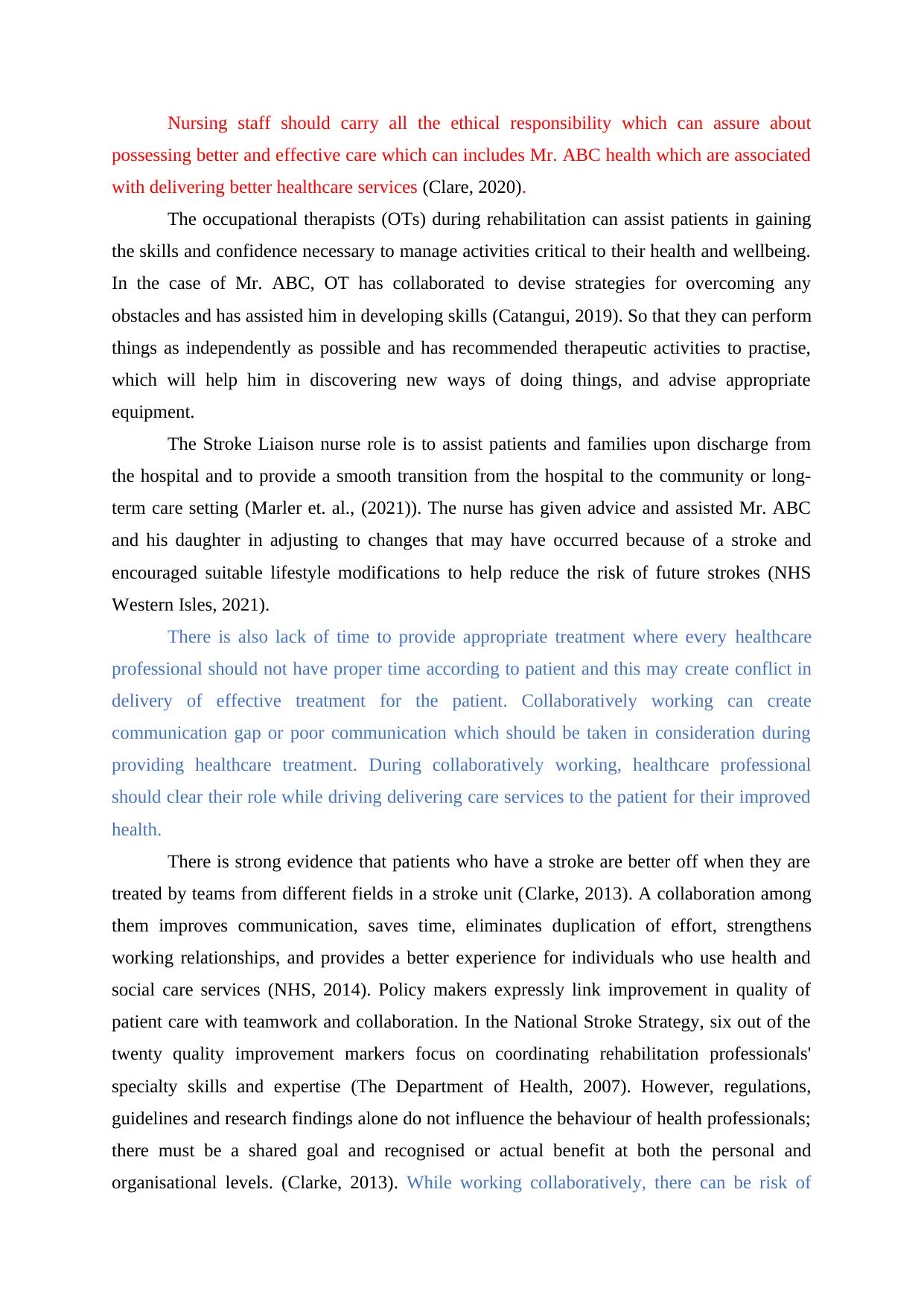
Nursing staff should carry all the ethical responsibility which can assure about
possessing better and effective care which can includes Mr. ABC health which are associated
with delivering better healthcare services (Clare, 2020).
The occupational therapists (OTs) during rehabilitation can assist patients in gaining
the skills and confidence necessary to manage activities critical to their health and wellbeing.
In the case of Mr. ABC, OT has collaborated to devise strategies for overcoming any
obstacles and has assisted him in developing skills (Catangui, 2019). So that they can perform
things as independently as possible and has recommended therapeutic activities to practise,
which will help him in discovering new ways of doing things, and advise appropriate
equipment.
The Stroke Liaison nurse role is to assist patients and families upon discharge from
the hospital and to provide a smooth transition from the hospital to the community or long-
term care setting (Marler et. al., (2021)). The nurse has given advice and assisted Mr. ABC
and his daughter in adjusting to changes that may have occurred because of a stroke and
encouraged suitable lifestyle modifications to help reduce the risk of future strokes (NHS
Western Isles, 2021).
There is also lack of time to provide appropriate treatment where every healthcare
professional should not have proper time according to patient and this may create conflict in
delivery of effective treatment for the patient. Collaboratively working can create
communication gap or poor communication which should be taken in consideration during
providing healthcare treatment. During collaboratively working, healthcare professional
should clear their role while driving delivering care services to the patient for their improved
health.
There is strong evidence that patients who have a stroke are better off when they are
treated by teams from different fields in a stroke unit (Clarke, 2013). A collaboration among
them improves communication, saves time, eliminates duplication of effort, strengthens
working relationships, and provides a better experience for individuals who use health and
social care services (NHS, 2014). Policy makers expressly link improvement in quality of
patient care with teamwork and collaboration. In the National Stroke Strategy, six out of the
twenty quality improvement markers focus on coordinating rehabilitation professionals'
specialty skills and expertise (The Department of Health, 2007). However, regulations,
guidelines and research findings alone do not influence the behaviour of health professionals;
there must be a shared goal and recognised or actual benefit at both the personal and
organisational levels. (Clarke, 2013). While working collaboratively, there can be risk of
possessing better and effective care which can includes Mr. ABC health which are associated
with delivering better healthcare services (Clare, 2020).
The occupational therapists (OTs) during rehabilitation can assist patients in gaining
the skills and confidence necessary to manage activities critical to their health and wellbeing.
In the case of Mr. ABC, OT has collaborated to devise strategies for overcoming any
obstacles and has assisted him in developing skills (Catangui, 2019). So that they can perform
things as independently as possible and has recommended therapeutic activities to practise,
which will help him in discovering new ways of doing things, and advise appropriate
equipment.
The Stroke Liaison nurse role is to assist patients and families upon discharge from
the hospital and to provide a smooth transition from the hospital to the community or long-
term care setting (Marler et. al., (2021)). The nurse has given advice and assisted Mr. ABC
and his daughter in adjusting to changes that may have occurred because of a stroke and
encouraged suitable lifestyle modifications to help reduce the risk of future strokes (NHS
Western Isles, 2021).
There is also lack of time to provide appropriate treatment where every healthcare
professional should not have proper time according to patient and this may create conflict in
delivery of effective treatment for the patient. Collaboratively working can create
communication gap or poor communication which should be taken in consideration during
providing healthcare treatment. During collaboratively working, healthcare professional
should clear their role while driving delivering care services to the patient for their improved
health.
There is strong evidence that patients who have a stroke are better off when they are
treated by teams from different fields in a stroke unit (Clarke, 2013). A collaboration among
them improves communication, saves time, eliminates duplication of effort, strengthens
working relationships, and provides a better experience for individuals who use health and
social care services (NHS, 2014). Policy makers expressly link improvement in quality of
patient care with teamwork and collaboration. In the National Stroke Strategy, six out of the
twenty quality improvement markers focus on coordinating rehabilitation professionals'
specialty skills and expertise (The Department of Health, 2007). However, regulations,
guidelines and research findings alone do not influence the behaviour of health professionals;
there must be a shared goal and recognised or actual benefit at both the personal and
organisational levels. (Clarke, 2013). While working collaboratively, there can be risk of
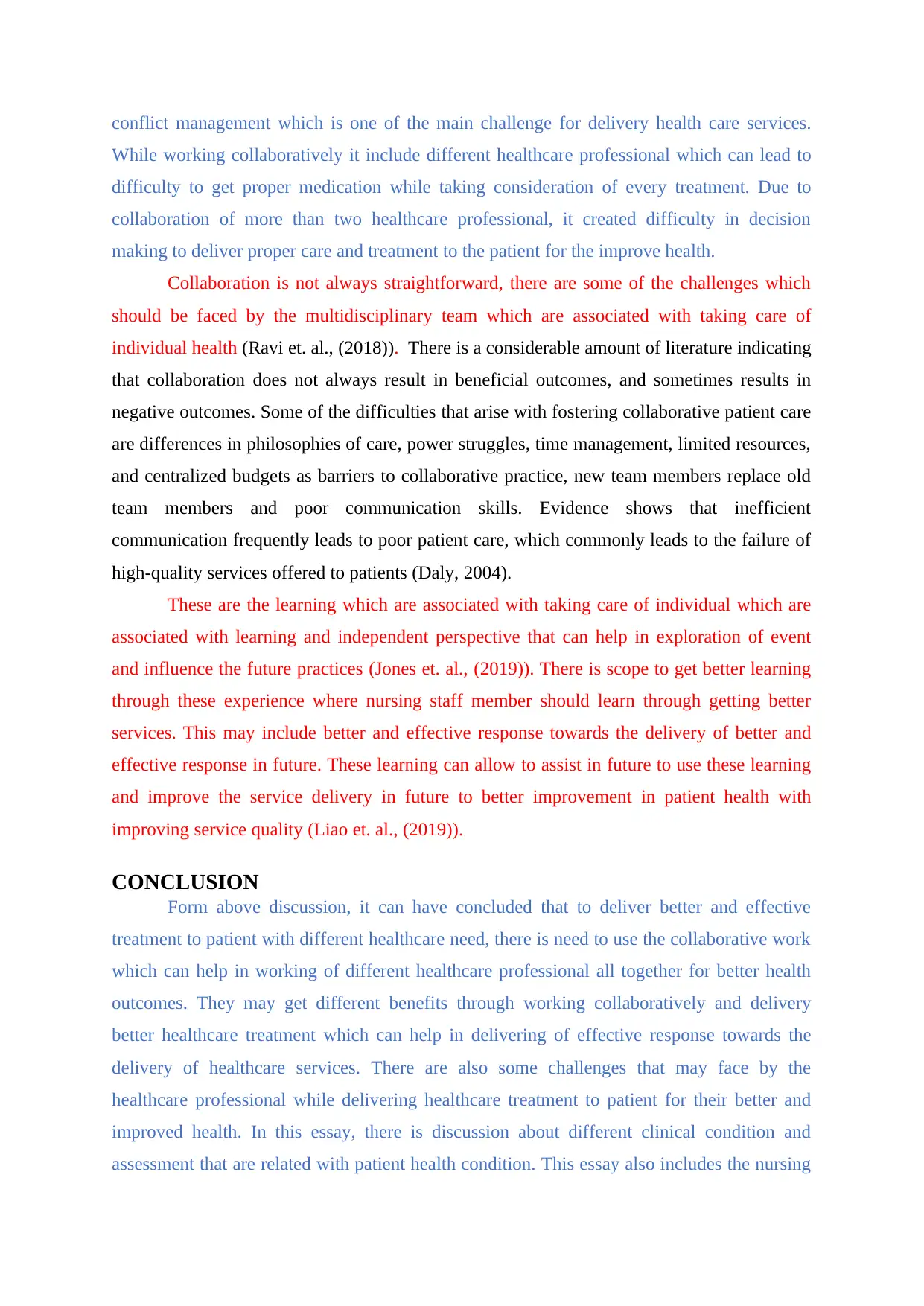
conflict management which is one of the main challenge for delivery health care services.
While working collaboratively it include different healthcare professional which can lead to
difficulty to get proper medication while taking consideration of every treatment. Due to
collaboration of more than two healthcare professional, it created difficulty in decision
making to deliver proper care and treatment to the patient for the improve health.
Collaboration is not always straightforward, there are some of the challenges which
should be faced by the multidisciplinary team which are associated with taking care of
individual health (Ravi et. al., (2018)). There is a considerable amount of literature indicating
that collaboration does not always result in beneficial outcomes, and sometimes results in
negative outcomes. Some of the difficulties that arise with fostering collaborative patient care
are differences in philosophies of care, power struggles, time management, limited resources,
and centralized budgets as barriers to collaborative practice, new team members replace old
team members and poor communication skills. Evidence shows that inefficient
communication frequently leads to poor patient care, which commonly leads to the failure of
high-quality services offered to patients (Daly, 2004).
These are the learning which are associated with taking care of individual which are
associated with learning and independent perspective that can help in exploration of event
and influence the future practices (Jones et. al., (2019)). There is scope to get better learning
through these experience where nursing staff member should learn through getting better
services. This may include better and effective response towards the delivery of better and
effective response in future. These learning can allow to assist in future to use these learning
and improve the service delivery in future to better improvement in patient health with
improving service quality (Liao et. al., (2019)).
CONCLUSION
Form above discussion, it can have concluded that to deliver better and effective
treatment to patient with different healthcare need, there is need to use the collaborative work
which can help in working of different healthcare professional all together for better health
outcomes. They may get different benefits through working collaboratively and delivery
better healthcare treatment which can help in delivering of effective response towards the
delivery of healthcare services. There are also some challenges that may face by the
healthcare professional while delivering healthcare treatment to patient for their better and
improved health. In this essay, there is discussion about different clinical condition and
assessment that are related with patient health condition. This essay also includes the nursing
While working collaboratively it include different healthcare professional which can lead to
difficulty to get proper medication while taking consideration of every treatment. Due to
collaboration of more than two healthcare professional, it created difficulty in decision
making to deliver proper care and treatment to the patient for the improve health.
Collaboration is not always straightforward, there are some of the challenges which
should be faced by the multidisciplinary team which are associated with taking care of
individual health (Ravi et. al., (2018)). There is a considerable amount of literature indicating
that collaboration does not always result in beneficial outcomes, and sometimes results in
negative outcomes. Some of the difficulties that arise with fostering collaborative patient care
are differences in philosophies of care, power struggles, time management, limited resources,
and centralized budgets as barriers to collaborative practice, new team members replace old
team members and poor communication skills. Evidence shows that inefficient
communication frequently leads to poor patient care, which commonly leads to the failure of
high-quality services offered to patients (Daly, 2004).
These are the learning which are associated with taking care of individual which are
associated with learning and independent perspective that can help in exploration of event
and influence the future practices (Jones et. al., (2019)). There is scope to get better learning
through these experience where nursing staff member should learn through getting better
services. This may include better and effective response towards the delivery of better and
effective response in future. These learning can allow to assist in future to use these learning
and improve the service delivery in future to better improvement in patient health with
improving service quality (Liao et. al., (2019)).
CONCLUSION
Form above discussion, it can have concluded that to deliver better and effective
treatment to patient with different healthcare need, there is need to use the collaborative work
which can help in working of different healthcare professional all together for better health
outcomes. They may get different benefits through working collaboratively and delivery
better healthcare treatment which can help in delivering of effective response towards the
delivery of healthcare services. There are also some challenges that may face by the
healthcare professional while delivering healthcare treatment to patient for their better and
improved health. In this essay, there is discussion about different clinical condition and
assessment that are related with patient health condition. This essay also includes the nursing
Paraphrase This Document
Need a fresh take? Get an instant paraphrase of this document with our AI Paraphraser
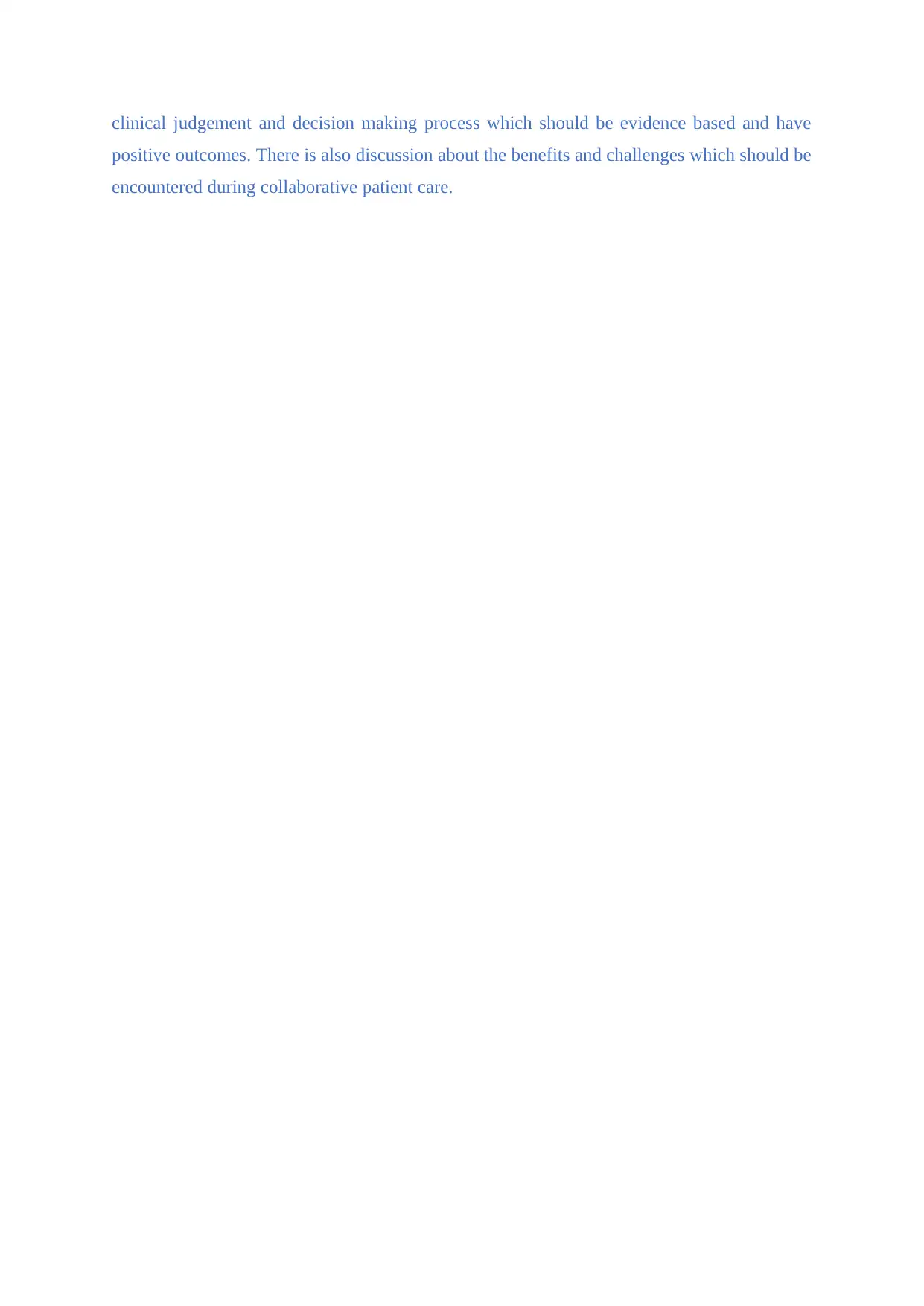
clinical judgement and decision making process which should be evidence based and have
positive outcomes. There is also discussion about the benefits and challenges which should be
encountered during collaborative patient care.
positive outcomes. There is also discussion about the benefits and challenges which should be
encountered during collaborative patient care.
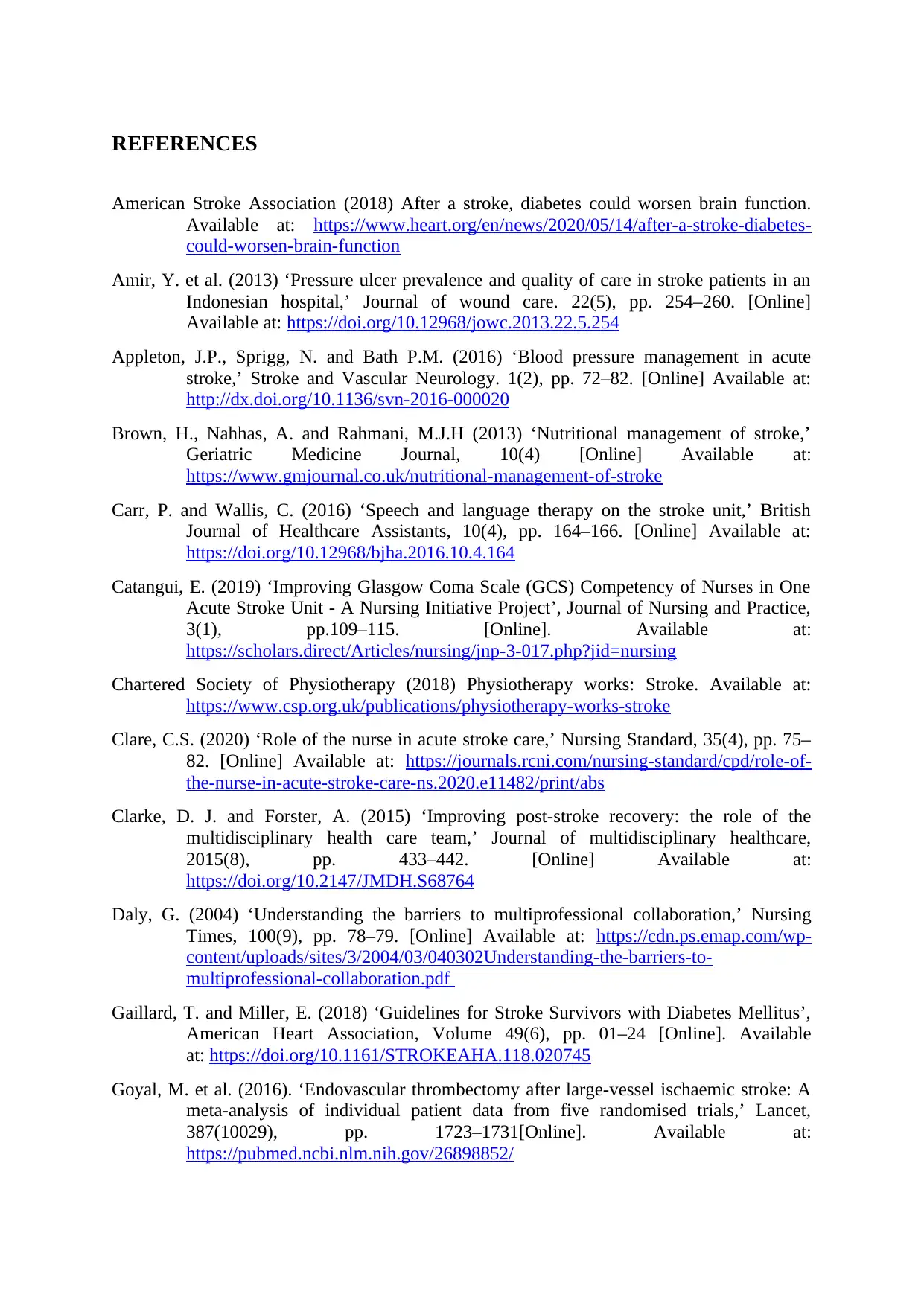
REFERENCES
American Stroke Association (2018) After a stroke, diabetes could worsen brain function.
Available at: https://www.heart.org/en/news/2020/05/14/after-a-stroke-diabetes-
could-worsen-brain-function
Amir, Y. et al. (2013) ‘Pressure ulcer prevalence and quality of care in stroke patients in an
Indonesian hospital,’ Journal of wound care. 22(5), pp. 254–260. [Online]
Available at: https://doi.org/10.12968/jowc.2013.22.5.254
Appleton, J.P., Sprigg, N. and Bath P.M. (2016) ‘Blood pressure management in acute
stroke,’ Stroke and Vascular Neurology. 1(2), pp. 72–82. [Online] Available at:
http://dx.doi.org/10.1136/svn-2016-000020
Brown, H., Nahhas, A. and Rahmani, M.J.H (2013) ‘Nutritional management of stroke,’
Geriatric Medicine Journal, 10(4) [Online] Available at:
https://www.gmjournal.co.uk/nutritional-management-of-stroke
Carr, P. and Wallis, C. (2016) ‘Speech and language therapy on the stroke unit,’ British
Journal of Healthcare Assistants, 10(4), pp. 164–166. [Online] Available at:
https://doi.org/10.12968/bjha.2016.10.4.164
Catangui, E. (2019) ‘Improving Glasgow Coma Scale (GCS) Competency of Nurses in One
Acute Stroke Unit - A Nursing Initiative Project’, Journal of Nursing and Practice,
3(1), pp.109–115. [Online]. Available at:
https://scholars.direct/Articles/nursing/jnp-3-017.php?jid=nursing
Chartered Society of Physiotherapy (2018) Physiotherapy works: Stroke. Available at:
https://www.csp.org.uk/publications/physiotherapy-works-stroke
Clare, C.S. (2020) ‘Role of the nurse in acute stroke care,’ Nursing Standard, 35(4), pp. 75–
82. [Online] Available at: https://journals.rcni.com/nursing-standard/cpd/role-of-
the-nurse-in-acute-stroke-care-ns.2020.e11482/print/abs
Clarke, D. J. and Forster, A. (2015) ‘Improving post-stroke recovery: the role of the
multidisciplinary health care team,’ Journal of multidisciplinary healthcare,
2015(8), pp. 433–442. [Online] Available at:
https://doi.org/10.2147/JMDH.S68764
Daly, G. (2004) ‘Understanding the barriers to multiprofessional collaboration,’ Nursing
Times, 100(9), pp. 78–79. [Online] Available at: https://cdn.ps.emap.com/wp-
content/uploads/sites/3/2004/03/040302Understanding-the-barriers-to-
multiprofessional-collaboration.pdf
Gaillard, T. and Miller, E. (2018) ‘Guidelines for Stroke Survivors with Diabetes Mellitus’,
American Heart Association, Volume 49(6), pp. 01–24 [Online]. Available
at: https://doi.org/10.1161/STROKEAHA.118.020745
Goyal, M. et al. (2016). ‘Endovascular thrombectomy after large-vessel ischaemic stroke: A
meta-analysis of individual patient data from five randomised trials,’ Lancet,
387(10029), pp. 1723–1731[Online]. Available at:
https://pubmed.ncbi.nlm.nih.gov/26898852/
American Stroke Association (2018) After a stroke, diabetes could worsen brain function.
Available at: https://www.heart.org/en/news/2020/05/14/after-a-stroke-diabetes-
could-worsen-brain-function
Amir, Y. et al. (2013) ‘Pressure ulcer prevalence and quality of care in stroke patients in an
Indonesian hospital,’ Journal of wound care. 22(5), pp. 254–260. [Online]
Available at: https://doi.org/10.12968/jowc.2013.22.5.254
Appleton, J.P., Sprigg, N. and Bath P.M. (2016) ‘Blood pressure management in acute
stroke,’ Stroke and Vascular Neurology. 1(2), pp. 72–82. [Online] Available at:
http://dx.doi.org/10.1136/svn-2016-000020
Brown, H., Nahhas, A. and Rahmani, M.J.H (2013) ‘Nutritional management of stroke,’
Geriatric Medicine Journal, 10(4) [Online] Available at:
https://www.gmjournal.co.uk/nutritional-management-of-stroke
Carr, P. and Wallis, C. (2016) ‘Speech and language therapy on the stroke unit,’ British
Journal of Healthcare Assistants, 10(4), pp. 164–166. [Online] Available at:
https://doi.org/10.12968/bjha.2016.10.4.164
Catangui, E. (2019) ‘Improving Glasgow Coma Scale (GCS) Competency of Nurses in One
Acute Stroke Unit - A Nursing Initiative Project’, Journal of Nursing and Practice,
3(1), pp.109–115. [Online]. Available at:
https://scholars.direct/Articles/nursing/jnp-3-017.php?jid=nursing
Chartered Society of Physiotherapy (2018) Physiotherapy works: Stroke. Available at:
https://www.csp.org.uk/publications/physiotherapy-works-stroke
Clare, C.S. (2020) ‘Role of the nurse in acute stroke care,’ Nursing Standard, 35(4), pp. 75–
82. [Online] Available at: https://journals.rcni.com/nursing-standard/cpd/role-of-
the-nurse-in-acute-stroke-care-ns.2020.e11482/print/abs
Clarke, D. J. and Forster, A. (2015) ‘Improving post-stroke recovery: the role of the
multidisciplinary health care team,’ Journal of multidisciplinary healthcare,
2015(8), pp. 433–442. [Online] Available at:
https://doi.org/10.2147/JMDH.S68764
Daly, G. (2004) ‘Understanding the barriers to multiprofessional collaboration,’ Nursing
Times, 100(9), pp. 78–79. [Online] Available at: https://cdn.ps.emap.com/wp-
content/uploads/sites/3/2004/03/040302Understanding-the-barriers-to-
multiprofessional-collaboration.pdf
Gaillard, T. and Miller, E. (2018) ‘Guidelines for Stroke Survivors with Diabetes Mellitus’,
American Heart Association, Volume 49(6), pp. 01–24 [Online]. Available
at: https://doi.org/10.1161/STROKEAHA.118.020745
Goyal, M. et al. (2016). ‘Endovascular thrombectomy after large-vessel ischaemic stroke: A
meta-analysis of individual patient data from five randomised trials,’ Lancet,
387(10029), pp. 1723–1731[Online]. Available at:
https://pubmed.ncbi.nlm.nih.gov/26898852/
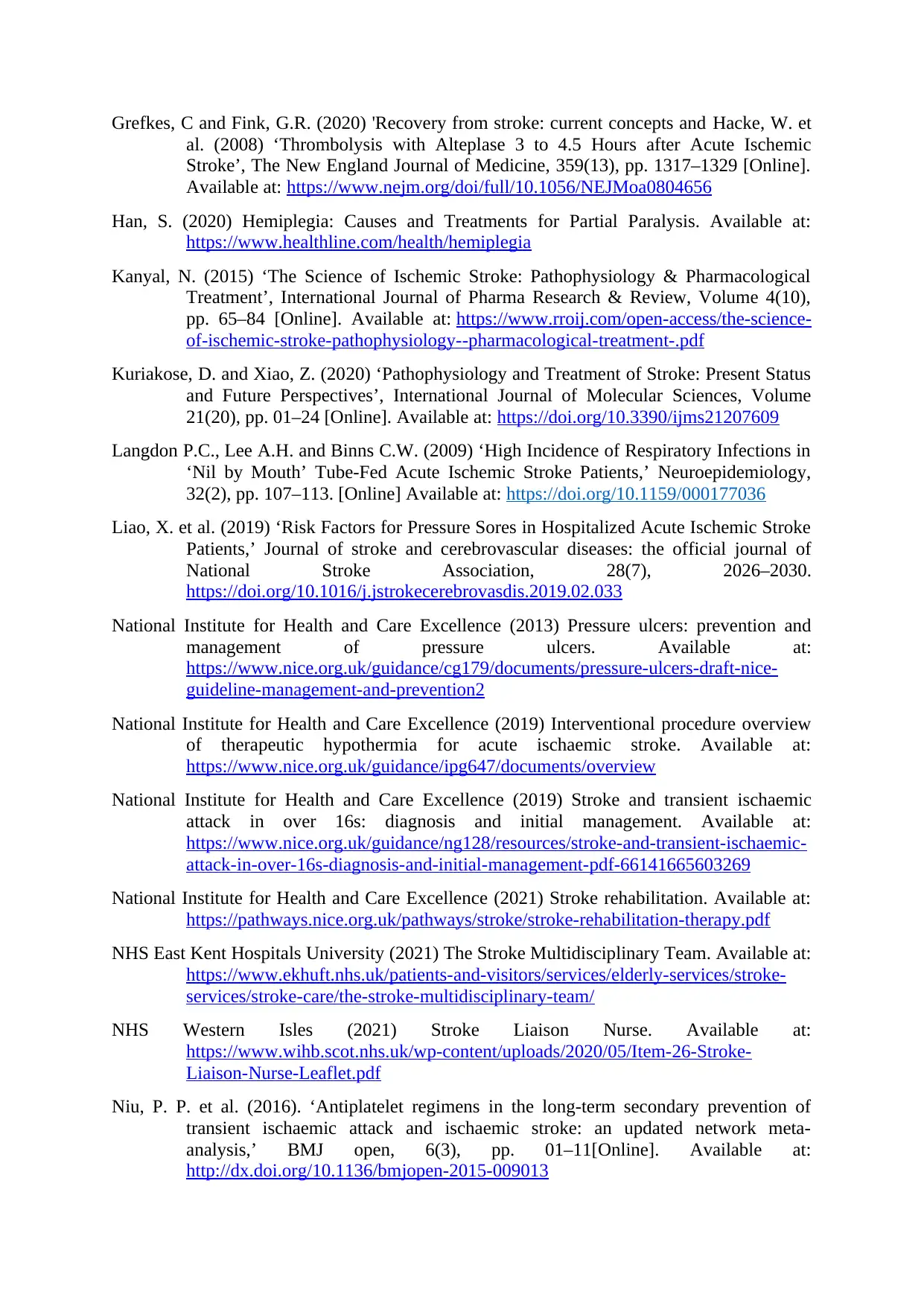
Grefkes, C and Fink, G.R. (2020) 'Recovery from stroke: current concepts and Hacke, W. et
al. (2008) ‘Thrombolysis with Alteplase 3 to 4.5 Hours after Acute Ischemic
Stroke’, The New England Journal of Medicine, 359(13), pp. 1317–1329 [Online].
Available at: https://www.nejm.org/doi/full/10.1056/NEJMoa0804656
Han, S. (2020) Hemiplegia: Causes and Treatments for Partial Paralysis. Available at:
https://www.healthline.com/health/hemiplegia
Kanyal, N. (2015) ‘The Science of Ischemic Stroke: Pathophysiology & Pharmacological
Treatment’, International Journal of Pharma Research & Review, Volume 4(10),
pp. 65–84 [Online]. Available at: https://www.rroij.com/open-access/the-science-
of-ischemic-stroke-pathophysiology--pharmacological-treatment-.pdf
Kuriakose, D. and Xiao, Z. (2020) ‘Pathophysiology and Treatment of Stroke: Present Status
and Future Perspectives’, International Journal of Molecular Sciences, Volume
21(20), pp. 01–24 [Online]. Available at: https://doi.org/10.3390/ijms21207609
Langdon P.C., Lee A.H. and Binns C.W. (2009) ‘High Incidence of Respiratory Infections in
‘Nil by Mouth’ Tube-Fed Acute Ischemic Stroke Patients,’ Neuroepidemiology,
32(2), pp. 107–113. [Online] Available at: https://doi.org/10.1159/000177036
Liao, X. et al. (2019) ‘Risk Factors for Pressure Sores in Hospitalized Acute Ischemic Stroke
Patients,’ Journal of stroke and cerebrovascular diseases: the official journal of
National Stroke Association, 28(7), 2026–2030.
https://doi.org/10.1016/j.jstrokecerebrovasdis.2019.02.033
National Institute for Health and Care Excellence (2013) Pressure ulcers: prevention and
management of pressure ulcers. Available at:
https://www.nice.org.uk/guidance/cg179/documents/pressure-ulcers-draft-nice-
guideline-management-and-prevention2
National Institute for Health and Care Excellence (2019) Interventional procedure overview
of therapeutic hypothermia for acute ischaemic stroke. Available at:
https://www.nice.org.uk/guidance/ipg647/documents/overview
National Institute for Health and Care Excellence (2019) Stroke and transient ischaemic
attack in over 16s: diagnosis and initial management. Available at:
https://www.nice.org.uk/guidance/ng128/resources/stroke-and-transient-ischaemic-
attack-in-over-16s-diagnosis-and-initial-management-pdf-66141665603269
National Institute for Health and Care Excellence (2021) Stroke rehabilitation. Available at:
https://pathways.nice.org.uk/pathways/stroke/stroke-rehabilitation-therapy.pdf
NHS East Kent Hospitals University (2021) The Stroke Multidisciplinary Team. Available at:
https://www.ekhuft.nhs.uk/patients-and-visitors/services/elderly-services/stroke-
services/stroke-care/the-stroke-multidisciplinary-team/
NHS Western Isles (2021) Stroke Liaison Nurse. Available at:
https://www.wihb.scot.nhs.uk/wp-content/uploads/2020/05/Item-26-Stroke-
Liaison-Nurse-Leaflet.pdf
Niu, P. P. et al. (2016). ‘Antiplatelet regimens in the long-term secondary prevention of
transient ischaemic attack and ischaemic stroke: an updated network meta-
analysis,’ BMJ open, 6(3), pp. 01–11[Online]. Available at:
http://dx.doi.org/10.1136/bmjopen-2015-009013
al. (2008) ‘Thrombolysis with Alteplase 3 to 4.5 Hours after Acute Ischemic
Stroke’, The New England Journal of Medicine, 359(13), pp. 1317–1329 [Online].
Available at: https://www.nejm.org/doi/full/10.1056/NEJMoa0804656
Han, S. (2020) Hemiplegia: Causes and Treatments for Partial Paralysis. Available at:
https://www.healthline.com/health/hemiplegia
Kanyal, N. (2015) ‘The Science of Ischemic Stroke: Pathophysiology & Pharmacological
Treatment’, International Journal of Pharma Research & Review, Volume 4(10),
pp. 65–84 [Online]. Available at: https://www.rroij.com/open-access/the-science-
of-ischemic-stroke-pathophysiology--pharmacological-treatment-.pdf
Kuriakose, D. and Xiao, Z. (2020) ‘Pathophysiology and Treatment of Stroke: Present Status
and Future Perspectives’, International Journal of Molecular Sciences, Volume
21(20), pp. 01–24 [Online]. Available at: https://doi.org/10.3390/ijms21207609
Langdon P.C., Lee A.H. and Binns C.W. (2009) ‘High Incidence of Respiratory Infections in
‘Nil by Mouth’ Tube-Fed Acute Ischemic Stroke Patients,’ Neuroepidemiology,
32(2), pp. 107–113. [Online] Available at: https://doi.org/10.1159/000177036
Liao, X. et al. (2019) ‘Risk Factors for Pressure Sores in Hospitalized Acute Ischemic Stroke
Patients,’ Journal of stroke and cerebrovascular diseases: the official journal of
National Stroke Association, 28(7), 2026–2030.
https://doi.org/10.1016/j.jstrokecerebrovasdis.2019.02.033
National Institute for Health and Care Excellence (2013) Pressure ulcers: prevention and
management of pressure ulcers. Available at:
https://www.nice.org.uk/guidance/cg179/documents/pressure-ulcers-draft-nice-
guideline-management-and-prevention2
National Institute for Health and Care Excellence (2019) Interventional procedure overview
of therapeutic hypothermia for acute ischaemic stroke. Available at:
https://www.nice.org.uk/guidance/ipg647/documents/overview
National Institute for Health and Care Excellence (2019) Stroke and transient ischaemic
attack in over 16s: diagnosis and initial management. Available at:
https://www.nice.org.uk/guidance/ng128/resources/stroke-and-transient-ischaemic-
attack-in-over-16s-diagnosis-and-initial-management-pdf-66141665603269
National Institute for Health and Care Excellence (2021) Stroke rehabilitation. Available at:
https://pathways.nice.org.uk/pathways/stroke/stroke-rehabilitation-therapy.pdf
NHS East Kent Hospitals University (2021) The Stroke Multidisciplinary Team. Available at:
https://www.ekhuft.nhs.uk/patients-and-visitors/services/elderly-services/stroke-
services/stroke-care/the-stroke-multidisciplinary-team/
NHS Western Isles (2021) Stroke Liaison Nurse. Available at:
https://www.wihb.scot.nhs.uk/wp-content/uploads/2020/05/Item-26-Stroke-
Liaison-Nurse-Leaflet.pdf
Niu, P. P. et al. (2016). ‘Antiplatelet regimens in the long-term secondary prevention of
transient ischaemic attack and ischaemic stroke: an updated network meta-
analysis,’ BMJ open, 6(3), pp. 01–11[Online]. Available at:
http://dx.doi.org/10.1136/bmjopen-2015-009013
Secure Best Marks with AI Grader
Need help grading? Try our AI Grader for instant feedback on your assignments.
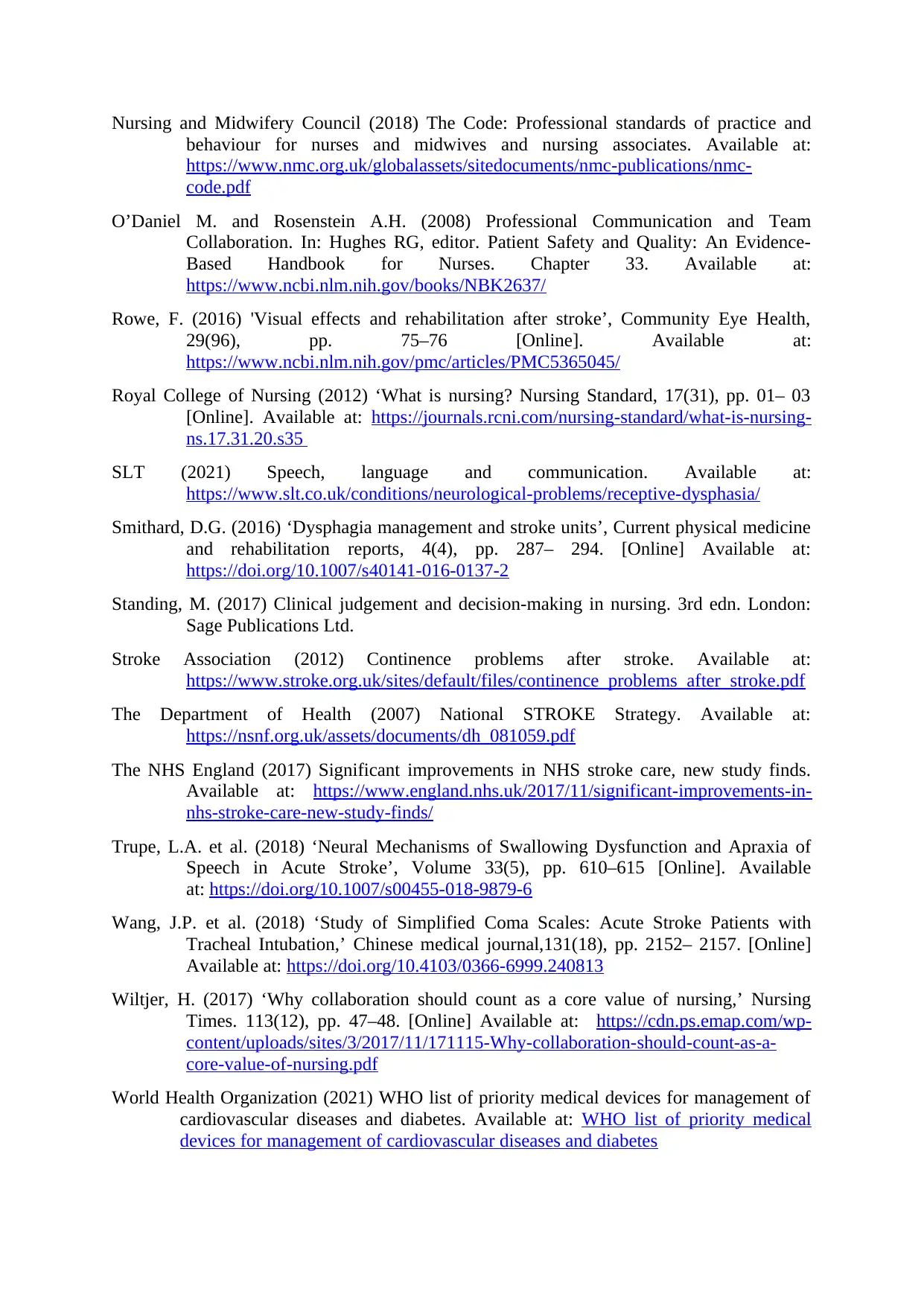
Nursing and Midwifery Council (2018) The Code: Professional standards of practice and
behaviour for nurses and midwives and nursing associates. Available at:
https://www.nmc.org.uk/globalassets/sitedocuments/nmc-publications/nmc-
code.pdf
O’Daniel M. and Rosenstein A.H. (2008) Professional Communication and Team
Collaboration. In: Hughes RG, editor. Patient Safety and Quality: An Evidence-
Based Handbook for Nurses. Chapter 33. Available at:
https://www.ncbi.nlm.nih.gov/books/NBK2637/
Rowe, F. (2016) 'Visual effects and rehabilitation after stroke’, Community Eye Health,
29(96), pp. 75–76 [Online]. Available at:
https://www.ncbi.nlm.nih.gov/pmc/articles/PMC5365045/
Royal College of Nursing (2012) ‘What is nursing? Nursing Standard, 17(31), pp. 01– 03
[Online]. Available at: https://journals.rcni.com/nursing-standard/what-is-nursing-
ns.17.31.20.s35
SLT (2021) Speech, language and communication. Available at:
https://www.slt.co.uk/conditions/neurological-problems/receptive-dysphasia/
Smithard, D.G. (2016) ‘Dysphagia management and stroke units’, Current physical medicine
and rehabilitation reports, 4(4), pp. 287– 294. [Online] Available at:
https://doi.org/10.1007/s40141-016-0137-2
Standing, M. (2017) Clinical judgement and decision-making in nursing. 3rd edn. London:
Sage Publications Ltd.
Stroke Association (2012) Continence problems after stroke. Available at:
https://www.stroke.org.uk/sites/default/files/continence_problems_after_stroke.pdf
The Department of Health (2007) National STROKE Strategy. Available at:
https://nsnf.org.uk/assets/documents/dh_081059.pdf
The NHS England (2017) Significant improvements in NHS stroke care, new study finds.
Available at: https://www.england.nhs.uk/2017/11/significant-improvements-in-
nhs-stroke-care-new-study-finds/
Trupe, L.A. et al. (2018) ‘Neural Mechanisms of Swallowing Dysfunction and Apraxia of
Speech in Acute Stroke’, Volume 33(5), pp. 610–615 [Online]. Available
at: https://doi.org/10.1007/s00455-018-9879-6
Wang, J.P. et al. (2018) ‘Study of Simplified Coma Scales: Acute Stroke Patients with
Tracheal Intubation,’ Chinese medical journal,131(18), pp. 2152– 2157. [Online]
Available at: https://doi.org/10.4103/0366-6999.240813
Wiltjer, H. (2017) ‘Why collaboration should count as a core value of nursing,’ Nursing
Times. 113(12), pp. 47–48. [Online] Available at: https://cdn.ps.emap.com/wp-
content/uploads/sites/3/2017/11/171115-Why-collaboration-should-count-as-a-
core-value-of-nursing.pdf
World Health Organization (2021) WHO list of priority medical devices for management of
cardiovascular diseases and diabetes. Available at: WHO list of priority medical
devices for management of cardiovascular diseases and diabetes
behaviour for nurses and midwives and nursing associates. Available at:
https://www.nmc.org.uk/globalassets/sitedocuments/nmc-publications/nmc-
code.pdf
O’Daniel M. and Rosenstein A.H. (2008) Professional Communication and Team
Collaboration. In: Hughes RG, editor. Patient Safety and Quality: An Evidence-
Based Handbook for Nurses. Chapter 33. Available at:
https://www.ncbi.nlm.nih.gov/books/NBK2637/
Rowe, F. (2016) 'Visual effects and rehabilitation after stroke’, Community Eye Health,
29(96), pp. 75–76 [Online]. Available at:
https://www.ncbi.nlm.nih.gov/pmc/articles/PMC5365045/
Royal College of Nursing (2012) ‘What is nursing? Nursing Standard, 17(31), pp. 01– 03
[Online]. Available at: https://journals.rcni.com/nursing-standard/what-is-nursing-
ns.17.31.20.s35
SLT (2021) Speech, language and communication. Available at:
https://www.slt.co.uk/conditions/neurological-problems/receptive-dysphasia/
Smithard, D.G. (2016) ‘Dysphagia management and stroke units’, Current physical medicine
and rehabilitation reports, 4(4), pp. 287– 294. [Online] Available at:
https://doi.org/10.1007/s40141-016-0137-2
Standing, M. (2017) Clinical judgement and decision-making in nursing. 3rd edn. London:
Sage Publications Ltd.
Stroke Association (2012) Continence problems after stroke. Available at:
https://www.stroke.org.uk/sites/default/files/continence_problems_after_stroke.pdf
The Department of Health (2007) National STROKE Strategy. Available at:
https://nsnf.org.uk/assets/documents/dh_081059.pdf
The NHS England (2017) Significant improvements in NHS stroke care, new study finds.
Available at: https://www.england.nhs.uk/2017/11/significant-improvements-in-
nhs-stroke-care-new-study-finds/
Trupe, L.A. et al. (2018) ‘Neural Mechanisms of Swallowing Dysfunction and Apraxia of
Speech in Acute Stroke’, Volume 33(5), pp. 610–615 [Online]. Available
at: https://doi.org/10.1007/s00455-018-9879-6
Wang, J.P. et al. (2018) ‘Study of Simplified Coma Scales: Acute Stroke Patients with
Tracheal Intubation,’ Chinese medical journal,131(18), pp. 2152– 2157. [Online]
Available at: https://doi.org/10.4103/0366-6999.240813
Wiltjer, H. (2017) ‘Why collaboration should count as a core value of nursing,’ Nursing
Times. 113(12), pp. 47–48. [Online] Available at: https://cdn.ps.emap.com/wp-
content/uploads/sites/3/2017/11/171115-Why-collaboration-should-count-as-a-
core-value-of-nursing.pdf
World Health Organization (2021) WHO list of priority medical devices for management of
cardiovascular diseases and diabetes. Available at: WHO list of priority medical
devices for management of cardiovascular diseases and diabetes
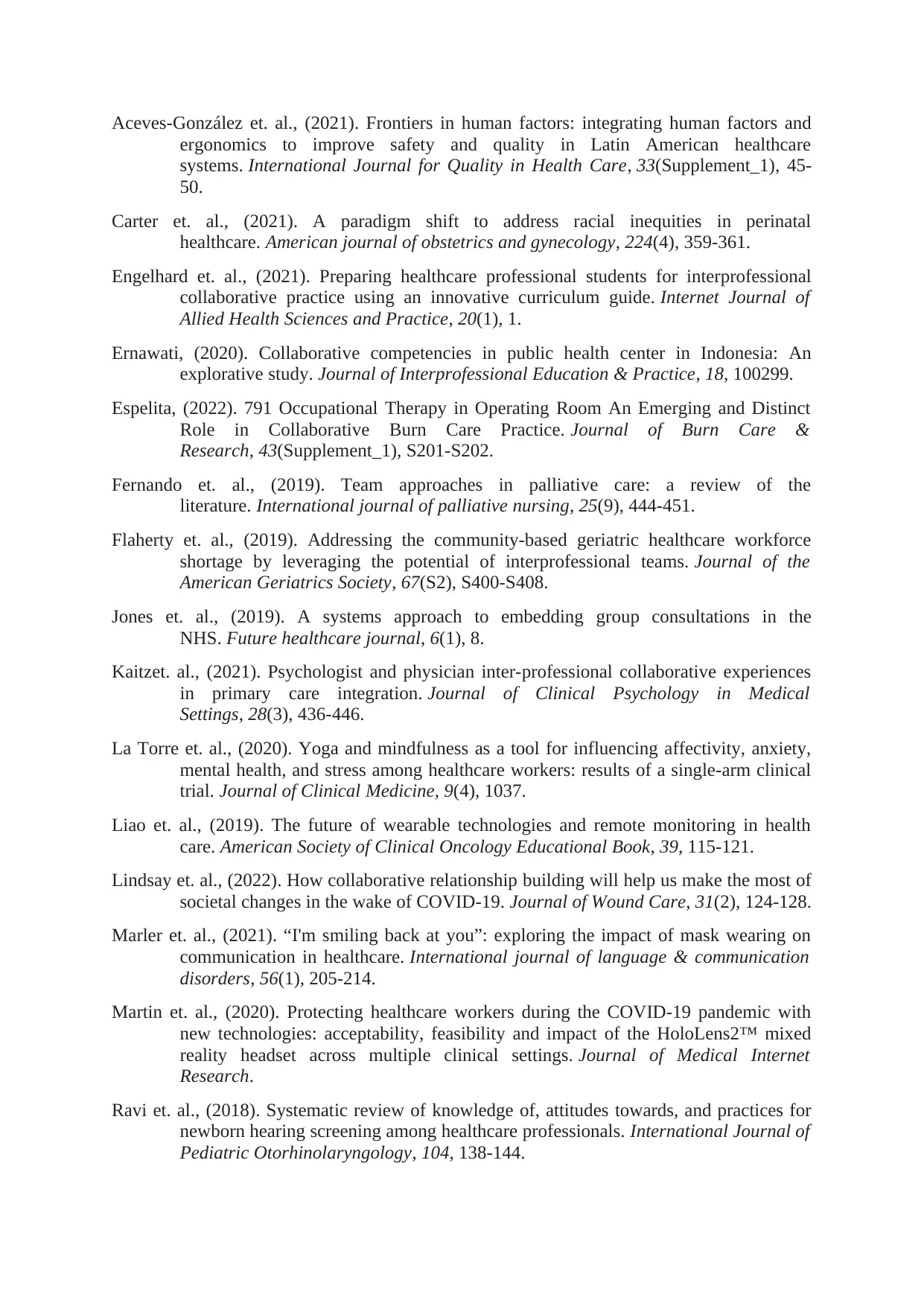
Aceves-González et. al., (2021). Frontiers in human factors: integrating human factors and
ergonomics to improve safety and quality in Latin American healthcare
systems. International Journal for Quality in Health Care, 33(Supplement_1), 45-
50.
Carter et. al., (2021). A paradigm shift to address racial inequities in perinatal
healthcare. American journal of obstetrics and gynecology, 224(4), 359-361.
Engelhard et. al., (2021). Preparing healthcare professional students for interprofessional
collaborative practice using an innovative curriculum guide. Internet Journal of
Allied Health Sciences and Practice, 20(1), 1.
Ernawati, (2020). Collaborative competencies in public health center in Indonesia: An
explorative study. Journal of Interprofessional Education & Practice, 18, 100299.
Espelita, (2022). 791 Occupational Therapy in Operating Room An Emerging and Distinct
Role in Collaborative Burn Care Practice. Journal of Burn Care &
Research, 43(Supplement_1), S201-S202.
Fernando et. al., (2019). Team approaches in palliative care: a review of the
literature. International journal of palliative nursing, 25(9), 444-451.
Flaherty et. al., (2019). Addressing the community‐based geriatric healthcare workforce
shortage by leveraging the potential of interprofessional teams. Journal of the
American Geriatrics Society, 67(S2), S400-S408.
Jones et. al., (2019). A systems approach to embedding group consultations in the
NHS. Future healthcare journal, 6(1), 8.
Kaitzet. al., (2021). Psychologist and physician inter-professional collaborative experiences
in primary care integration. Journal of Clinical Psychology in Medical
Settings, 28(3), 436-446.
La Torre et. al., (2020). Yoga and mindfulness as a tool for influencing affectivity, anxiety,
mental health, and stress among healthcare workers: results of a single-arm clinical
trial. Journal of Clinical Medicine, 9(4), 1037.
Liao et. al., (2019). The future of wearable technologies and remote monitoring in health
care. American Society of Clinical Oncology Educational Book, 39, 115-121.
Lindsay et. al., (2022). How collaborative relationship building will help us make the most of
societal changes in the wake of COVID-19. Journal of Wound Care, 31(2), 124-128.
Marler et. al., (2021). “I'm smiling back at you”: exploring the impact of mask wearing on
communication in healthcare. International journal of language & communication
disorders, 56(1), 205-214.
Martin et. al., (2020). Protecting healthcare workers during the COVID-19 pandemic with
new technologies: acceptability, feasibility and impact of the HoloLens2™ mixed
reality headset across multiple clinical settings. Journal of Medical Internet
Research.
Ravi et. al., (2018). Systematic review of knowledge of, attitudes towards, and practices for
newborn hearing screening among healthcare professionals. International Journal of
Pediatric Otorhinolaryngology, 104, 138-144.
ergonomics to improve safety and quality in Latin American healthcare
systems. International Journal for Quality in Health Care, 33(Supplement_1), 45-
50.
Carter et. al., (2021). A paradigm shift to address racial inequities in perinatal
healthcare. American journal of obstetrics and gynecology, 224(4), 359-361.
Engelhard et. al., (2021). Preparing healthcare professional students for interprofessional
collaborative practice using an innovative curriculum guide. Internet Journal of
Allied Health Sciences and Practice, 20(1), 1.
Ernawati, (2020). Collaborative competencies in public health center in Indonesia: An
explorative study. Journal of Interprofessional Education & Practice, 18, 100299.
Espelita, (2022). 791 Occupational Therapy in Operating Room An Emerging and Distinct
Role in Collaborative Burn Care Practice. Journal of Burn Care &
Research, 43(Supplement_1), S201-S202.
Fernando et. al., (2019). Team approaches in palliative care: a review of the
literature. International journal of palliative nursing, 25(9), 444-451.
Flaherty et. al., (2019). Addressing the community‐based geriatric healthcare workforce
shortage by leveraging the potential of interprofessional teams. Journal of the
American Geriatrics Society, 67(S2), S400-S408.
Jones et. al., (2019). A systems approach to embedding group consultations in the
NHS. Future healthcare journal, 6(1), 8.
Kaitzet. al., (2021). Psychologist and physician inter-professional collaborative experiences
in primary care integration. Journal of Clinical Psychology in Medical
Settings, 28(3), 436-446.
La Torre et. al., (2020). Yoga and mindfulness as a tool for influencing affectivity, anxiety,
mental health, and stress among healthcare workers: results of a single-arm clinical
trial. Journal of Clinical Medicine, 9(4), 1037.
Liao et. al., (2019). The future of wearable technologies and remote monitoring in health
care. American Society of Clinical Oncology Educational Book, 39, 115-121.
Lindsay et. al., (2022). How collaborative relationship building will help us make the most of
societal changes in the wake of COVID-19. Journal of Wound Care, 31(2), 124-128.
Marler et. al., (2021). “I'm smiling back at you”: exploring the impact of mask wearing on
communication in healthcare. International journal of language & communication
disorders, 56(1), 205-214.
Martin et. al., (2020). Protecting healthcare workers during the COVID-19 pandemic with
new technologies: acceptability, feasibility and impact of the HoloLens2™ mixed
reality headset across multiple clinical settings. Journal of Medical Internet
Research.
Ravi et. al., (2018). Systematic review of knowledge of, attitudes towards, and practices for
newborn hearing screening among healthcare professionals. International Journal of
Pediatric Otorhinolaryngology, 104, 138-144.
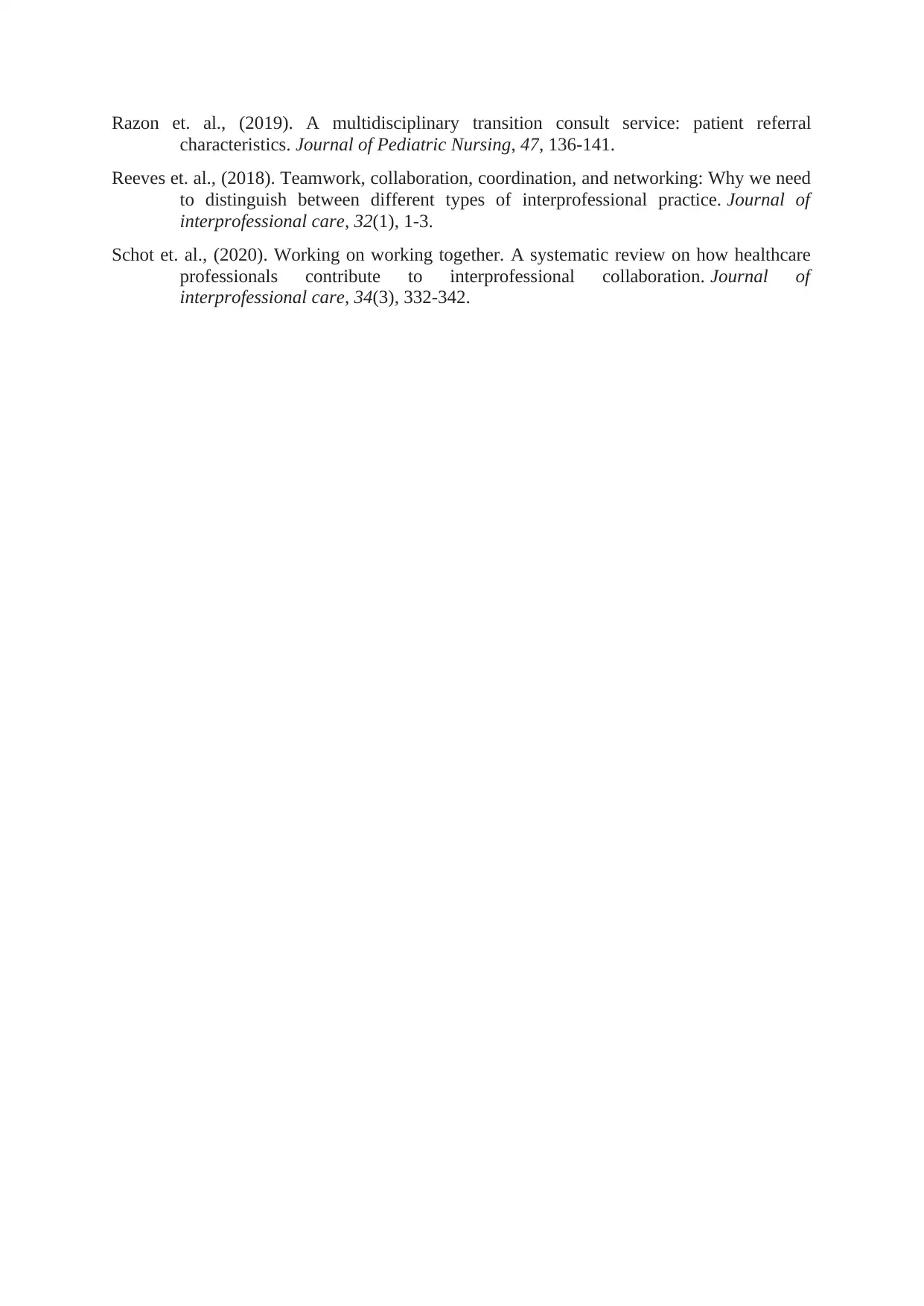
Razon et. al., (2019). A multidisciplinary transition consult service: patient referral
characteristics. Journal of Pediatric Nursing, 47, 136-141.
Reeves et. al., (2018). Teamwork, collaboration, coordination, and networking: Why we need
to distinguish between different types of interprofessional practice. Journal of
interprofessional care, 32(1), 1-3.
Schot et. al., (2020). Working on working together. A systematic review on how healthcare
professionals contribute to interprofessional collaboration. Journal of
interprofessional care, 34(3), 332-342.
characteristics. Journal of Pediatric Nursing, 47, 136-141.
Reeves et. al., (2018). Teamwork, collaboration, coordination, and networking: Why we need
to distinguish between different types of interprofessional practice. Journal of
interprofessional care, 32(1), 1-3.
Schot et. al., (2020). Working on working together. A systematic review on how healthcare
professionals contribute to interprofessional collaboration. Journal of
interprofessional care, 34(3), 332-342.
Paraphrase This Document
Need a fresh take? Get an instant paraphrase of this document with our AI Paraphraser
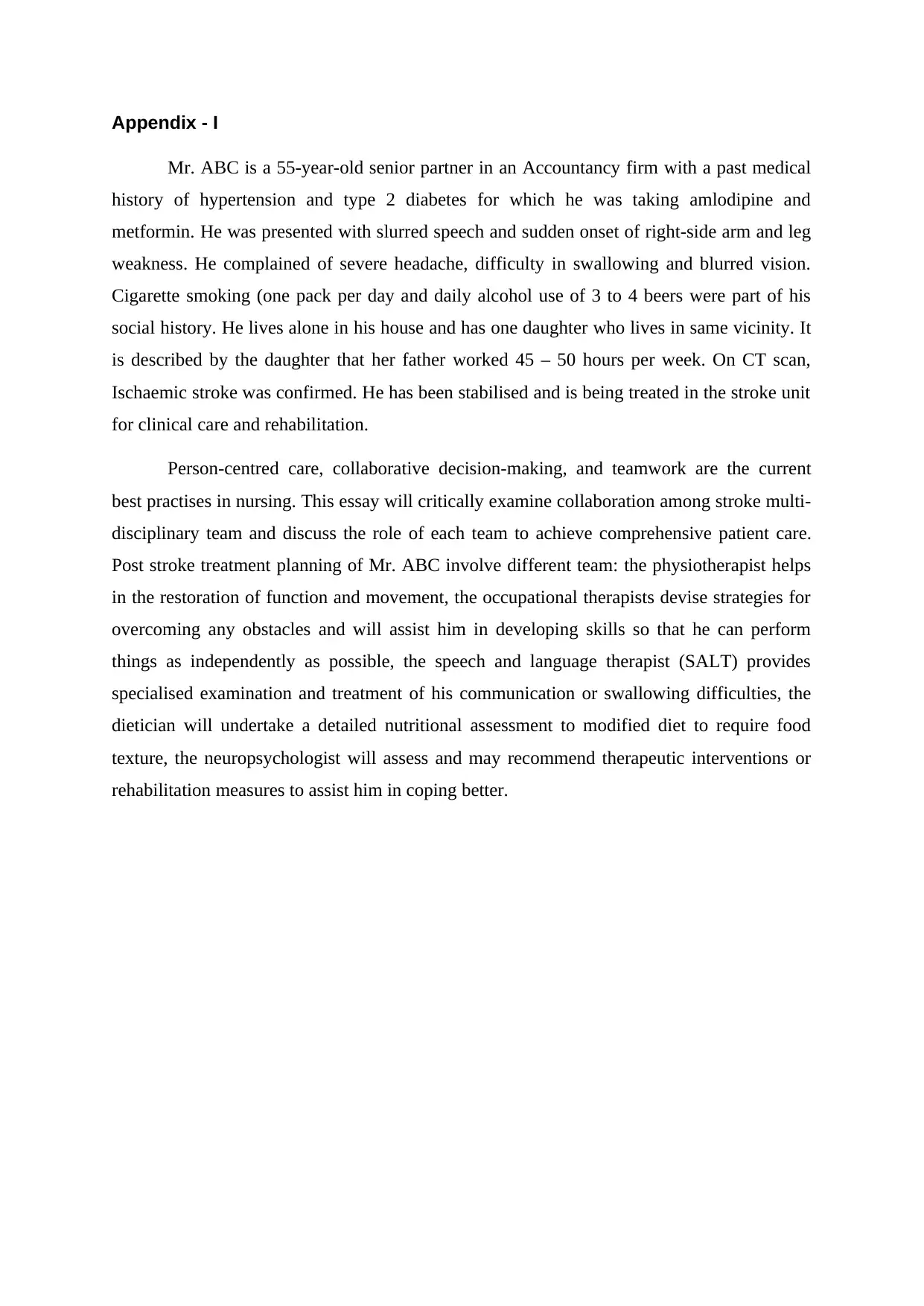
Appendix - I
Mr. ABC is a 55-year-old senior partner in an Accountancy firm with a past medical
history of hypertension and type 2 diabetes for which he was taking amlodipine and
metformin. He was presented with slurred speech and sudden onset of right-side arm and leg
weakness. He complained of severe headache, difficulty in swallowing and blurred vision.
Cigarette smoking (one pack per day and daily alcohol use of 3 to 4 beers were part of his
social history. He lives alone in his house and has one daughter who lives in same vicinity. It
is described by the daughter that her father worked 45 – 50 hours per week. On CT scan,
Ischaemic stroke was confirmed. He has been stabilised and is being treated in the stroke unit
for clinical care and rehabilitation.
Person-centred care, collaborative decision-making, and teamwork are the current
best practises in nursing. This essay will critically examine collaboration among stroke multi-
disciplinary team and discuss the role of each team to achieve comprehensive patient care.
Post stroke treatment planning of Mr. ABC involve different team: the physiotherapist helps
in the restoration of function and movement, the occupational therapists devise strategies for
overcoming any obstacles and will assist him in developing skills so that he can perform
things as independently as possible, the speech and language therapist (SALT) provides
specialised examination and treatment of his communication or swallowing difficulties, the
dietician will undertake a detailed nutritional assessment to modified diet to require food
texture, the neuropsychologist will assess and may recommend therapeutic interventions or
rehabilitation measures to assist him in coping better.
Mr. ABC is a 55-year-old senior partner in an Accountancy firm with a past medical
history of hypertension and type 2 diabetes for which he was taking amlodipine and
metformin. He was presented with slurred speech and sudden onset of right-side arm and leg
weakness. He complained of severe headache, difficulty in swallowing and blurred vision.
Cigarette smoking (one pack per day and daily alcohol use of 3 to 4 beers were part of his
social history. He lives alone in his house and has one daughter who lives in same vicinity. It
is described by the daughter that her father worked 45 – 50 hours per week. On CT scan,
Ischaemic stroke was confirmed. He has been stabilised and is being treated in the stroke unit
for clinical care and rehabilitation.
Person-centred care, collaborative decision-making, and teamwork are the current
best practises in nursing. This essay will critically examine collaboration among stroke multi-
disciplinary team and discuss the role of each team to achieve comprehensive patient care.
Post stroke treatment planning of Mr. ABC involve different team: the physiotherapist helps
in the restoration of function and movement, the occupational therapists devise strategies for
overcoming any obstacles and will assist him in developing skills so that he can perform
things as independently as possible, the speech and language therapist (SALT) provides
specialised examination and treatment of his communication or swallowing difficulties, the
dietician will undertake a detailed nutritional assessment to modified diet to require food
texture, the neuropsychologist will assess and may recommend therapeutic interventions or
rehabilitation measures to assist him in coping better.
1 out of 14
Related Documents
Your All-in-One AI-Powered Toolkit for Academic Success.
+13062052269
info@desklib.com
Available 24*7 on WhatsApp / Email
![[object Object]](/_next/static/media/star-bottom.7253800d.svg)
Unlock your academic potential
© 2024 | Zucol Services PVT LTD | All rights reserved.





